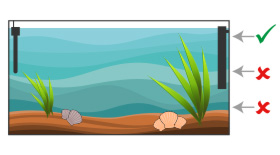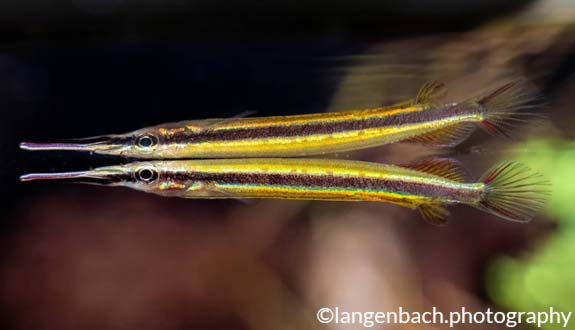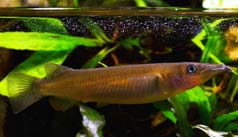

Alternative species (click on the thumbnail to see the card)
Names
Scientific name
Hemirhamphodon tengah
Common name
Borneo Redline Halfbeak
Origin

Origin: Indonesia (Borneo)
Biotope: Asian
Dimorphism

Hardly visible. The female is slightly larger and slightly less colourful than the male.
Group

Hemiramphidae
Volume

30 L / 6 imp gal / 8 US gal
Parameters

T°: 25 to 26°C or 77 to 79°F
pH: 5 to 6
Hardness: 4 to 10°dGH
Difficulty

Average
Size

3 to 4.5cm (1.2 to 1.8")
Longevity

2 to 5 years
Living zone

Top
Individuals

6
Food
How to feed the Hemirhamphodon tengah?
Food
How to feed the Hemirhamphodon tengah?
Somewhat delicate, Hemirhamphodons will eat in captivity daphnia, culex, drosophila, artemia, white or black mosquito larvae and other micro-worms... Ideally, these prey will be alive, failing that, frozen. Floating dry food is also accepted. Distribute several small meals per day.
Note that this fish feeds exclusively on the surface and quite slowly.
Behavior
What kind of behavior does the Hemirhamphodon tengah have?
Behavior
What kind of behavior does the Hemirhamphodon tengah have?
They need the presence of their fellow creatures to satisfy their gregarious instincts. Maintain at least a small group of 6 individuals, males and females combined.
Hemirhamphodons live strictly at the top of the aquarium, just below the surface. This area should provide plenty of hiding places for these very shy fish (for example, Salvinia or Ceratophyllum will do very well).
Cohabitation
Who can live with the Hemirhamphodon tengah?
Cohabitation
Who can live with the Hemirhamphodon tengah?
These little fish are pretty shy. Ideally, opt for specific aquarium maintenance. In this case, a nano-aquarium may be sufficient.
In order to associate it correctly with other species, plan a larger aquarium and pay attention to the water parameters and food competition (Hemirhamphodons eat slowly). You can combine it with chocolate gouramis (Sphaerichthys osphromenoides) or small, peaceful rasboras.
Breeding
How to breed the Hemirhamphodon tengah?
Breeding
How to breed the Hemirhamphodon tengah?
The reproduction of Hemirhamphodons is quite difficult for beginners given the water parameters required for egg development. Indeed, they only mature in water with a pH below 6.5 and very soft (3 to 4°dGH).
Fertilization is internal. Therefore, after spawning, the female deposits the already fertilized eggs on large leaves.
Incubation lasts about 3 weeks at 25°C (77°F). At hatching, the young are already 1 cm long and will continue to grow quite quickly. Their "beak" seems folded as they grow, but don't worry, it won't take its straight shape until later!
Fry food: Artemia nauplia.
Its aquarium
Which aquarium for the Hemirhamphodon tengah?
Its aquarium
Which aquarium for the Hemirhamphodon tengah?
The maintenance of this species is possible from 30 liters, but the larger the aquarium, the more stable the parameters and the easier the maintenance.
These shy fish need a lot of hiding places and shaded areas to reassure them. Plant your aquarium abundantly, especially on the surface (floating plants are ideal in this case!) otherwise they will be constantly stressed.
Good To know
Find all additional information!
Good To know
Find all additional information!
Contrary to what one sometimes reads, half-beechs of the Hemirhamphodon genus do not live in brackish water, on the contrary! They are strictly linked to very soft and acidic water!
Usually the species of demi-becs are ovoviviparous (hatching of the eggs inside the female), but this species is an exception! It is oviparous (eggs are laid and hatching occurs afterwards).
Yours photos!
Comments
Sort by:
Please login to post comments


